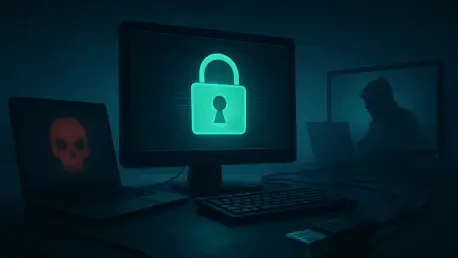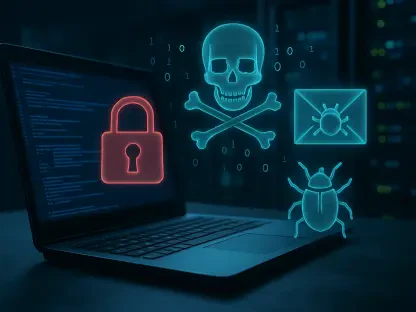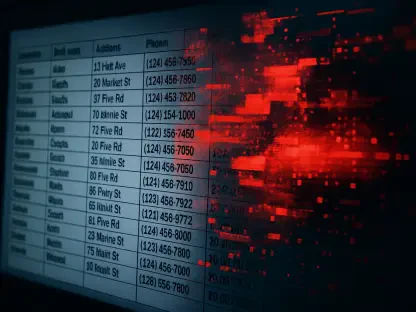In a stark reminder of the relentless pace of cyber threats, a critical vulnerability in Gladinet’s Triofox platform, a tool trusted by countless businesses for secure file sharing and remote access, has come under active exploitation by sophisticated attackers. Identified as CVE-2025-12480 with a CVSS score of 9.1, this unauthenticated access flaw enables malicious actors to sidestep security protocols, infiltrate internal setup pages, and execute harmful code on systems that remain unpatched. This alarming development underscores a persistent challenge in cybersecurity: the speed at which threat actors capitalize on vulnerabilities often outstrips the ability of organizations to apply fixes. As businesses increasingly rely on digital tools for operational efficiency, such incidents highlight the urgent need for robust defense mechanisms and rapid response strategies to protect sensitive data and infrastructure from unauthorized access and control.
Emerging Threats in File-Sharing Platforms
Unveiling a Critical Security Gap
The discovery of CVE-2025-12480 in the Triofox platform has sent shockwaves through the cybersecurity community, revealing a severe flaw that allows attackers to gain unauthorized entry without authentication. This vulnerability, rated at near-maximum severity with a CVSS score of 9.1, grants malicious actors the ability to access restricted setup pages and inject malicious code directly into affected systems. Cybersecurity researchers have noted that the exploitation of this gap is not a theoretical risk but an active campaign orchestrated by a threat group dubbed UNC6485. These attackers have demonstrated a keen understanding of the platform’s weaknesses, using the flaw to establish rogue admin accounts with full system privileges. The ease with which such access can be obtained on unpatched systems serves as a grim reminder of the potential consequences of delayed updates, pushing organizations to prioritize immediate remediation to safeguard their digital environments from compromise.
Sophisticated Attack Chains Unraveled
Beyond simply gaining access, the UNC6485 group has employed a multi-layered attack strategy to maximize their control over compromised Triofox systems. After creating a rogue account named “Cluster Admin,” the attackers reconfigured the platform’s built-in antivirus feature—a tool meant for protection—to execute a malicious script hosted on a remote IP address. This script paved the way for the installation of legitimate software like Zoho Unified Endpoint Management System, which was then exploited to deploy remote access tools such as Zoho Assist and AnyDesk. These tools enabled full server control, allowing reconnaissance, credential tampering, and privilege escalation to both local and domain administrator levels. The ingenuity of repurposing trusted software for malicious purposes illustrates a growing trend in cybercrime, where attackers blend into normal system operations, making detection by traditional security measures exceptionally challenging for defenders.
Strengthening Defenses Against Evolving Threats
The Urgency of Timely System Updates
Despite the release of a patch for the Triofox vulnerability in version 16.7.10368.56560 earlier this year, exploitation of unpatched systems continued to be observed weeks after the fix became available. This delay in update adoption among users mirrors a broader industry trend where organizations often lag in applying critical patches, leaving systems exposed to opportunistic attackers. Cybersecurity experts emphasize that this incident marks the third exploited Triofox flaw reported this year, highlighting an accelerating pattern of cybercriminals weaponizing disclosed vulnerabilities faster than many businesses can respond. To counter this, system administrators are strongly advised to upgrade to the latest Triofox release without delay, as even a short window of vulnerability can result in significant breaches. Proactive patch management must become a cornerstone of organizational security to close the gap that attackers so readily exploit.
Building Robust Monitoring and Mitigation Strategies
In addition to timely updates, enhancing system resilience requires a comprehensive approach to monitoring and mitigation to thwart sophisticated threats like those posed by UNC6485. Security teams should audit admin accounts for unauthorized additions, such as the “Cluster Admin” profile, and scrutinize antivirus configurations to prevent the execution of rogue scripts. Monitoring for unusual SSH or RDP traffic is also critical, as attackers in this campaign used legitimate tools like Plink and PuTTY to establish encrypted tunnels for covert access over port 433, effectively masking communications with command-and-control servers. Specific hunting queries provided by cybersecurity researchers can aid in detecting attacker tools and anomalous outbound traffic. By adopting these measures, organizations can better position themselves to identify and neutralize threats before they escalate, ensuring that legitimate software is not turned against them in the hands of adversaries seeking persistent access to critical systems.
Reflecting on Past Lessons for Future Security
Looking back, the exploitation of the Triofox platform by the UNC6485 group revealed critical lapses in patch adoption that allowed attackers to maintain a foothold in vulnerable systems well after fixes were available. The misuse of legitimate tools for malicious ends further complicated detection efforts, as security teams struggled to distinguish between normal and harmful activity. For the future, organizations must commit to accelerated patch deployment and invest in advanced monitoring solutions to stay ahead of rapidly evolving threats. Exploring automated update systems and integrating threat intelligence into daily operations could provide a vital edge in identifying suspicious behavior early. As cybercriminals continue to adapt, the focus should remain on fostering a culture of vigilance and preparedness, ensuring that past oversights transform into actionable strategies for safeguarding digital assets against tomorrow’s challenges.









